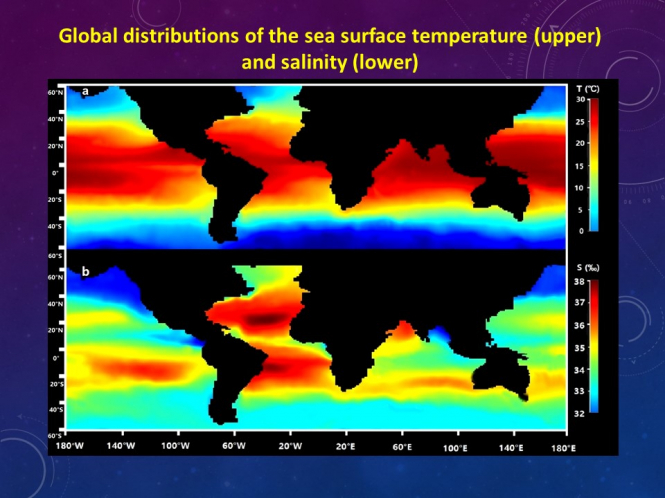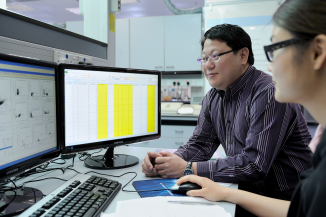Media
HKU and Chinese Research Academy of Environmental Sciences jointly develop a novel scientific method to derive water quality criteria of metals for protecting different marine ecosystems worldwide
24 Apr 2018

Global distributions of the sea surface temperature and salinity, which vary among different geographical regions
Increasing contamination of marine ecosystems by metals such as mercury, cadmium, chromium and nickel has been a global environmental concern, because elevated concentrations of metals can pose hazards to marine organisms, and humans who may consume contaminated seafood.
Setting water quality criteria (WQC) of various metals (i.e., environmental safety limits) is an essential step for assessing and regulating their risk levels in the marine environment, and hence offering protection to marine organisms and ecosystem integrity.
At present, the current method for deriving WQC of metals in Australia, Europe and North America is primarily based on laboratory data generated from toxicity tests with different marine organisms that are conducted at fixed laboratory conditions (e.g. a fixed combination of temperature and salinity). Such laboratory-derived WQC may not be protective to various marine ecosystems because environmental conditions in the natural environment are often very different from those of the laboratory setting. In reality, the environmental conditions vary among different geographic regions (e.g. tropics vs. temperate regions); even at the same region, environmental conditions such as water temperature and salinity change seasonally. Such changes can substantially influence the toxicities of metals to marine organisms.
Over the past decade, environmental scientists have been looking for a way to predict the toxicities of metals and derive their WQC for protecting the biodiversity and integrity of marine ecosystems with different environmental conditions. This task is tremendously important to environmental protection.
Professor Kenneth Leung, Deputy Director of School of Biological Sciences and Scientist of the Swire Institute of Marine Science of HKU, teams up with Professor Wu Fengchang, Director of State Key Laboratory of Environmental Criteria and Risk Assessment at Chinese Research Academy of Environmental Sciences (CRAES) and Academician of Chinese Academy of Engineering to jointly tackle this global issue. Their team has spent three years of effort to develop a novel empirical model for estimating the toxicities and deriving WQC for metals and metalloids in coastal marine environments with variable temperature and salinity regimes. Their method is based on an integration of temperature- and salinity-based species sensitivity distributions (SSDs) with quantitative ion characteristic relationships (QICAR) model, while parts of their model results are validated with empirical data. The team also analyses real-time environmental data of sea surface temperature and salinity in different parts of the world and applies their model to derive provisional site-specific WQC for more than 30 metals and metalloids.

Professor Kenneth Leung (Left), Deputy Director of School of Biological Sciences of HKU, and Professor Wu Fengchang (Right), Academician of Chinese Academy of Engineering at Chinese Research Academy of Environmental Sciences (CRAES) present their research discoveries at the 2nd International Conference on Deriving Environmental Quality Standards for the Protection of Aquatic Ecosystems (EQSPAE-2016) held at HKU in June 2016.
The research team, for the first time, successfully makes use of big data and develops the novel model for predicting metal toxicities and deriving their site-specific WQC in different marine environments worldwide. This important innovation has been published in the latest issue of the international journal Environmental Science & Technology.
The results indicate that metal toxicities to marine organisms generally increase with increasing seawater temperature, but the metal toxicities are found to be the lowest at an optimum salinity and increase when the salinity increases or decreases from the optimum salinity. If an WQC of a metal is derived from a laboratory experiment conducted at optimum temperature and salinity, such an WQC unlikely be protective to marine organisms which are living in an environment with higher temperature and lower salinity.
The results also suggest that marine species living in warmer waters in the tropical region (including Hong Kong and South China) are more susceptible to metal toxicities than their temperate counterparts. Many governments in Asia such as Hong Kong and Korea often employ temperate toxicity data for deriving WQC or directly adopt the WQC generated from Europe and North America, but such surrogate uses of temperate information for protecting tropical marine ecosystems pose high uncertainty in the margin of safety.
The novel method developed by the team will greatly improve the management of metal and metalloids in coastal marine environments worldwide, as environmental authorities can employ this method to derive provisional site-specific WQC for facilitating better ecosystem protection with consideration of specific environmental conditions and potential influences of global climate change.
Professor Wu Fengchang said: “Professor Kenneth Leung and his team at HKU have already revealed the temperature- and salinity-dependent toxicity profiles of various pollutants and produced the relevant empirical datasets, while our team at CRAES is good at quantitative structure-activity relationship modelling for metal toxicities. Our complementary knowledge and skills are prerequisite of the success of this collaborative project. We are very delighted to work together.”
Professor Wu also views that the results of this study will be of enormous benefit in deriving WQC of metals for different parts of marine environments in China and beyond.
Professor Kenneth Leung said: “In Hong Kong, salinity in the western marine waters is relatively low due to freshwater discharge from the Pearl River, whereas the salinity in the eastern waters is consistently high because of dominant influence of oceanic currents from Pacific Ocean and South China Sea. With consideration of such salinity differences, the method developed by the team can be readily applied to derive provisional site-specific WQC of metals for enabling better protection to the eastern and western marine ecosystems of Hong Kong, respectively.”
“Our new method not only enables different countries to derive site-specific WQC of metals for safeguarding their marine environments, it will also bring socioeconomic benefits to societies around the world. It is because we can reduce the number of toxicity tests, use less chemicals in the tests, kill fewer animals, and greatly save money and time for conducting such tests.” Professor Leung added.
The research team will further investigate the influence of dissolved and suspended organic matter on toxicities of metals in seawater, with a view to improving their model. They will also make use of field-based monitoring data of metal concentrations and marine biodiversity to validate their derived provisional WQC in different water bodies.
This research project is partially funded by Research Grants Council via a General Research Fund.
Link of the article: https://pubs.acs.org/doi/abs/10.1021/acs.est.7b06654
More about marine pollution and ecotoxicology research of Professor Kenneth Leung’s laboratory:
http://www.biosch.hku.hk/ecology/kenny.html
Image download and illustration: http://www.scifac.hku.hk/news/media?page=1
For media enquiries, please contact Mr Benjamin Miu, Faculty of Science, HKU (tel: 3917 4948/ email: benmiu@hku.hk) or Professor Kenneth Leung, HKU School of Biological Sciences by email at kmyleung@hku.hk.

